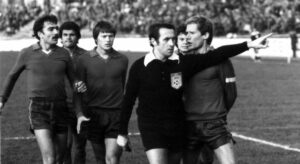After investing heavily in football in counties where the percentage of the Hungarian population is the highest in Romania, (in Hargita/Harghita County, where it is 85 percent, and in Kovászna/Covasna County, where it is 74 percent), the Hungarian government is now planning to do the same in Marosvásárhely/Târgu Mureș, where the largest Hungarian community, over 70,000 people, lives, writes Bucharest sport newspaper Gazeta Sporturilor (GSP) in an article titled “Hungary conquers Transylvania!” Budapest sports newspaper Nemzeti Sport asked local sports managers to clarify the article’s statements.
The Hungarian government is continuing its strategy of investing and building football clubs in Romania, in areas where large ethnic Hungarian communities live, writes GSP. It further states that according to their information, the next big project, in which the funding will come from Hungary, will be in Marosvásárhely, where a new football club has been desired, following the same philosophy as that of FK Csíkszereda and Sepsi OSK.
The percentage of Hungarians in Marosvásárhely (43 percent) is lower than in Csíkszereda/Miercurea Ciuc (76 percent) and Sepsiszentgyörgy/Sfântu Gheorghe (74 percent); however, in terms of absolute values, because Marosvásárhely’s overall population is bigger than the two other towns’ combined, the biggest ethnic Hungarian community in Transylvania (more than 70,000 people) lives in Marosvsásárhely. It also has the brightest football history, although its present performance is not so great, with only one football team in the 4th League. GSP’s article states that the Hungarian government decided to support football in Marosvásárhely following the municipal elections last September, when after 20 years, the inhabitants of Marosvásárhely elected a Hungarian mayor.
What is certain is that two months after the municipal elections, in November 2020, the local Hungarian newspaper Népújság had an interview with the new mayor, focusing on the future of sports life in Marosvásárhely, and Zoltán Soós said the following about the topic:
“In regard to football, we are thinking about a joint solution. It is not a secret that there were and that there will be a reconciliation with Puskás Academy [editor’s note: football club in the Hungarian 1st League], and that we would like for Marosvásárhely’s football to come back to the level it deserves. (…) I would like to have only one football team in the town, because it is not possible to finance more, and I hope that by the end of this mandate, Marosvásárhely will be at least in the 2nd League.”

The most famous club of Marosvásárhely was called ASA, the abbreviation of Asociaţia Sportivă Armata (Military’s Sports Association). ASA was founded in the early 1960s, and its biggest success was second place in the Romanian 1st League in 1975, only 3 points away from the champion Dinamo; in the next season, it finished in third place after Steaua and Dinamo. László Bölöni, who stood 108 times on the Romanian National team, and who is now coaching the legendary Greek club of Panathinaikos, was a member of this team from 1970 to 1984.
After the fall of communism, the original ASA was first relegated to the 2nd League; then, in 2002, it reached the 3rd League, while in 2005, as a result of the abolishment of military sports teams, it ceased to exist.
But only three years later, the town founded a new club with the name of FCM, which was later renamed to ASA. Although this new ASA could not reach the records of the old club, it still spent five seasons in the 1st League; in the 2014-15 season, the team finished in second place behind FCSB and won the Romanian Super Cup. But then, serious financial problems occurred pushing the club into insolvency in the spring of 2016; less than two years later, it declared bankruptcy, and in February 2018, the club ceased to exist. Since then, in the past three years, the highest level any team from Marosvásárhely has reached was the 3rd League.
According to Nemzeti Sport, out of the football teams in Marosvásárhely, only one (Marosvásárhelyi Sportegyesület 1898) receives indirect support from the Hungarian state, as this club is one of the subcenters of the Szeklerland Football Academy operating in Csíkszereda.
“We only receive support through them, and solely for the junior teams and the two artificial grass fields, but that is also just a small part of our budget,” said club president Attila Zoltán Csibi to Nemzeti Sport; according to him, the option of direct support from Hungary to the club has never occurred.
According to Zoltán Szondy, leader of the Szekler Football Academy (and also FK Csíkszereda football club president), all Hungarian government support for Transylvanian football projects, including the one in Marosvásárhely, is going through them. Besides providing professional counseling for MSE 1898, the training center’s construction is ongoing in Marosszentgyörgy (Sângeorgiu de Mureș), a suburb of Marosvásárhely.
“Besides the two artificial grass fields, we are also planning two grass ones and a small-sized stand. We want to help resurrect Marosvásárely football life at the adult level too,” said Zoltán Szondy to Nemzeti Sport.
Title image is an illustration: ASA playing against FC Hermannstadt in the 2nd League in October 2017, only a few months before it ceased to exist. (Photo: Pixel ProSport)